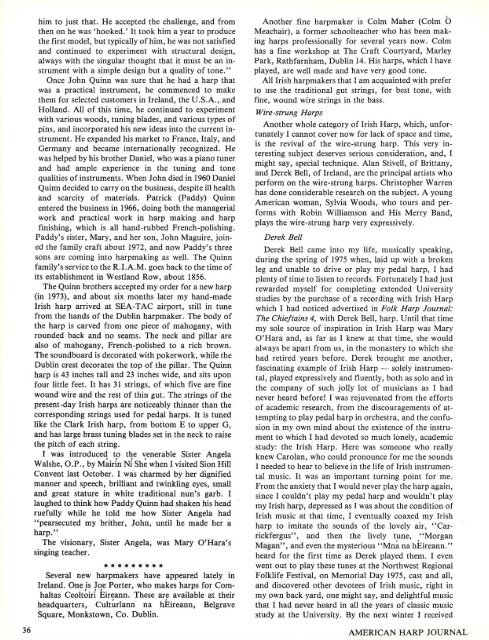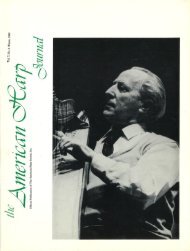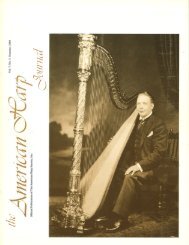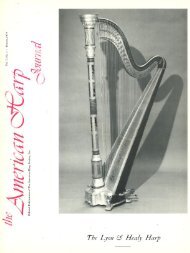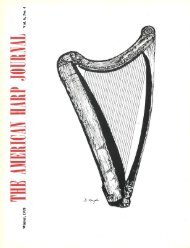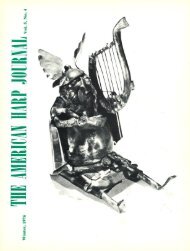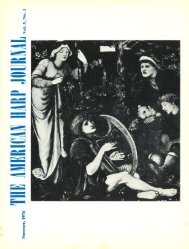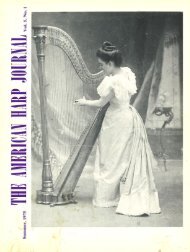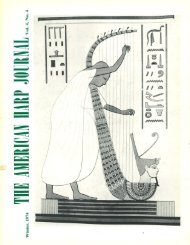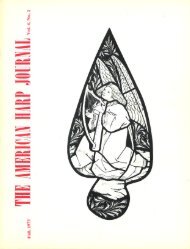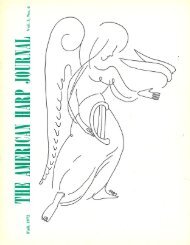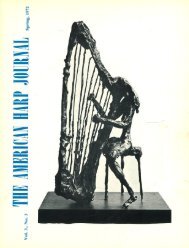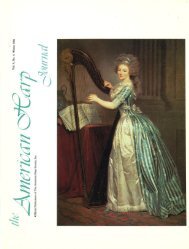AHJ, Vol. 7 No. 1, Summer 1979
AHJ, Vol. 7 No. 1, Summer 1979
AHJ, Vol. 7 No. 1, Summer 1979
Create successful ePaper yourself
Turn your PDF publications into a flip-book with our unique Google optimized e-Paper software.
36<br />
him to just that. He accepted the challenge, and from<br />
then on he was 'hooked.' It took him a year to produce<br />
the first model, but typically of him, he was not satisfied<br />
and continued to experiment with structural design,<br />
always with the singular thought that it must be an instrument<br />
with a simple design but a quality of tone."<br />
Once John Quinn was sure that he had a harp that<br />
was a practical instrument, he commenced to make<br />
them for selected customers in Ireland, the U.S.A., and<br />
Holland. All of this time, he continued to experiment<br />
with various woods, tuning blades, and various types of<br />
pins, and incorporated his new ideas into the current instrument.<br />
He expanded his market to France, Italy, and<br />
Germany and became internationally recognized. He<br />
was helped by his brother Daniel, who was a piano tuner<br />
and had ample experience in the tuning and tone<br />
qualities of instruments. When John died in 1960 Daniel<br />
Quinn decided to carry on the business, despite ill health<br />
and scarcity of materials. Patrick (Paddy) Quinn<br />
entered the business in 1966, doing both the managerial<br />
work and practical work in harp making and harp<br />
finishing, which is all hand-rubbed French-polishing.<br />
Paddy's sister, Mary, and her son, John Maguire, joined<br />
the family craft about 1972, and now Paddy's three<br />
sons are coming into harpmaking as well. The Quinn<br />
family's service to the R.I.A.M. goes back to the time of<br />
its establishment in Westland Row, about 1856.<br />
The Quinn brothers accepted my order for a new harp<br />
(in 1973), and about six months later my hand-made<br />
Irish harp arrived at SEA-TAC airport, still in tune<br />
from the hands of the Dublin harpmaker. The body of<br />
the harp is carved from one piece of mahogany, with<br />
rounded back and no seams. The neck and pillar are<br />
also of mahogany, French-polished to a rich brown.<br />
The soundboard is decorated with pokerwork, while the<br />
Dublin crest decorates the top of the pillar. The Quinn<br />
harp is 43 inches tall and 23 inches wide, and sits upon<br />
four little feet. It has 31 strings, of which five are fine<br />
wound wire and the rest of thin gut. The strings of the<br />
present-day Irish harps are noticeably thinner than the<br />
corresponding strings used for pedal harps. It is tuned<br />
like the Clark Irish harp, from bottom E to upper G,<br />
and has large brass tuning blades set in the neck to raise<br />
the pitch of each string.<br />
I was introduced to the venerable Sister Angela<br />
Walshe, O.P., by M~irin Ni Sh~ when I visited Sion Hill<br />
Convent last October. I was charmed by her dignified<br />
manner and speech, brilliant and twinkling eyes, small<br />
and great stature in white traditional nun's garb. I<br />
laughed to think how Paddy Quinn had shaken his head<br />
ruefully while he told me how Sister Angela had<br />
"pearsecuted my brither, John, until he made her a<br />
harp."<br />
The visionary, Sister Angela, was Mary O'Hara's<br />
singing teacher.<br />
• • • • • • • • •<br />
Several new harpmakers have appeared lately in<br />
Ireland. One is Joe Porter, who makes harps for Comhaltas<br />
Ceoltoiri Eireann. These are available at their<br />
headquarters, Cult~rlann na hEireann, Belgrave<br />
Square, Monkstown, Co. Dublin.<br />
Another fine harpmaker is Calm Maher (Calm b<br />
Meachair), a former schoolteacher who has been making<br />
harps professionally for several years now. Calm<br />
has a fine workshop at The Craft Courtyard, Marley<br />
Park, Rathfarnham, Dublin 14. His harps, which I have<br />
played, are well made and have very good tone.<br />
All Irish harpmakers that I am acquainted with prefer<br />
to use the traditional gut strings, for best tone, with<br />
fine, wound wire strings in the bass.<br />
Wire-strung Harps<br />
Another whole category of Irish Harp, which, unfortunately<br />
I cannot cover now for lack of space and time,<br />
is the revival of the wire-strung harp. This very interesting<br />
subject deserves serious consideration, and, I<br />
might say, special technique. Alan Stivell, of Brittany,<br />
and Derek Bell, of Ireland, are the principal artists who<br />
perform on the wire-strung harps. Christopher Warren<br />
has done considerable research on the subject. A young<br />
American woman, Sylvia Woods, who tours and performs<br />
with Robin Williamson and His Merry Band,<br />
plays the wire-strung harp very expressively.<br />
Derek Bell<br />
Derek Bell came into my life, musically speaking,<br />
during the spring of 1975 when, laid up with a broken<br />
leg and unable to drive or play my pedal harp, I had<br />
plenty of time to listen to records. Fortunately I had just<br />
rewarded myself for completing extended University<br />
studies by the purchase of a recording with Irish Harp<br />
which I had noticed advertised in Folk Harp Journal:<br />
The Chieftains 4, with Derek Bell, harp. Until that time<br />
my sole source of inspiration in Irish Harp was Mary<br />
O'Hara and, as far as I knew at that time, she would<br />
always be apart from us, in the monastery to which she<br />
had retired years before. Derek brought me another,<br />
fascinating example of Irish Harp - solely instrumental,<br />
played expressively and fluently, both as solo and in<br />
the company of such jolly lot of musicians as I had<br />
never heard before! I was rejuvenated from the efforts<br />
of academic research, from the discouragements of attempting<br />
to play pedal harp in orchestra, and the confusion<br />
in my own mind about the existence of the instrument<br />
to which I had devoted so much lonely, academic<br />
study: the Irish Harp. Here was someone who really<br />
knew Carolan, who could pronounce for me the sounds<br />
I needed to hear to believe in the life of Irish instrumental<br />
music. It was an important turning point for me.<br />
From the anxiety that I would never play the harp again,<br />
since I couldn't play my pedal harp and wouldn't play<br />
my Irish harp, depressed as I was about the condition of<br />
Irish music at that time, I eventually coaxed my Irish<br />
harp to imitate the sounds of the lovely air, "Carrickfergus",<br />
and then the lively tune, "Morgan<br />
Magan", and even the mysterious "Mn~ na hEireann."<br />
heard for the first time as Derek played them. I even<br />
went out to play these tunes at the <strong>No</strong>rthwest Regional<br />
Folklife Festival, on Memorial Day 1975, cast and all,<br />
and discovered other devotees of Irish music, right in<br />
my own back yard, one might say, and delightful music<br />
that I had never heard in all the years of classic music<br />
study at the University. By the next winter I received<br />
AMERICAN HARP JOURNAL


